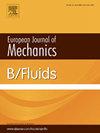Analysis of flow structure of liquid metal pulsating cross flow in-line tube bundles with various pitch-to-diameter ratio
IF 2.5
3区 工程技术
Q2 MECHANICS
引用次数: 0
Abstract
In order to further improve the efficiency and safety of tube bundle heat exchangers, liquid metal cross flow tube bundles under pulsating inlet flow conditions are investigated in this paper. The simulation study is carried out using the k-kl-ω turbulence model, which has been validated by previous experimental data, for in-line tube bundles with different arrangements. The numerical studies were carried out for pulsating velocity amplitude of 0.5, frequency of 10, and Re of 20,000 with transverse and streamwise pitch-to-diameter ratios of 1.5, 1.65, and 1.8. The analysis of the circumferential pressure drop factor of the tube bundle reveals that the pulsating flow excites the secondary flow at the back side of the bundle, which strengthens the local flow field, while the increase in global pressure drop is more pronounced at a smaller pitch ratio. Enlarged figure of the local time-averaged flow field show the differential flow behaviors at different pitch ratios, further revealing the obvious asymmetric characteristics of the secondary flow. The local secondary flow time-averaged results show that the first three columns of secondary flow are enhanced more than three times as much as in normal flow. Finally, the time series of secondary flow is analyzed by using power spectral density, continuous wavelet transform, and combined with Gaussian multimodal decomposition to reveal the representative secondary flow change characteristics at the back side of the tube in the first three columns. Finally, the distribution map of vortex structure features under the simulation parameters of this paper is given.
不同节径比下液态金属脉动横流直列管束流动结构分析
为了进一步提高管束式换热器的效率和安全性,本文对脉动进口流动条件下的液态金属横流管束进行了研究。本文采用k-kl-ω湍流模型对不同排列方式的直列管束进行了仿真研究,该模型已得到实验数据的验证。在脉动速度幅值为0.5、频率为10、Re为20,000、横向和纵向节径比分别为1.5、1.65和1.8的条件下进行了数值研究。对管束周向压降系数的分析表明,脉动流动激发了管束后侧的二次流,增强了局部流场,而当节距比较小时,整体压降的增加更为明显。局部时均流场放大图显示了不同节距比下的流动特性差异,进一步揭示了二次流明显的非对称特征。局部二次流时均结果表明,二次流前三列的强度是正常流动时的3倍以上。最后,利用功率谱密度、连续小波变换,结合高斯多模态分解对二次流时间序列进行分析,揭示了前三列中具有代表性的管内后侧二次流变化特征。最后给出了在本文模拟参数下的涡结构特征分布图。
本文章由计算机程序翻译,如有差异,请以英文原文为准。
求助全文
约1分钟内获得全文
求助全文
来源期刊
CiteScore
5.90
自引率
3.80%
发文量
127
审稿时长
58 days
期刊介绍:
The European Journal of Mechanics - B/Fluids publishes papers in all fields of fluid mechanics. Although investigations in well-established areas are within the scope of the journal, recent developments and innovative ideas are particularly welcome. Theoretical, computational and experimental papers are equally welcome. Mathematical methods, be they deterministic or stochastic, analytical or numerical, will be accepted provided they serve to clarify some identifiable problems in fluid mechanics, and provided the significance of results is explained. Similarly, experimental papers must add physical insight in to the understanding of fluid mechanics.

 求助内容:
求助内容: 应助结果提醒方式:
应助结果提醒方式:


